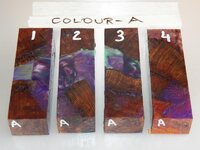There is been a great number of very accurate and responsible suggestions given in this thread so, is no point in me repeating any of those but focus on areas that haven't been clarified yet (if I read everything right...!).
I have no experience with Alumilite or any of the polyurethane resins, here is Australia is prohibitive to buy that stuff, the price of a 20lt drum of epoxy/polyurethane resin is about AU$1,250, while a good crystal clean Polyester resin (PR), costs about AU$250 plus shipping on both cases...!
So, is not difficult to work out why I only use Polyester resin to make my Resifill (castings). If the prices were identical, I would be using both of them why...??? Because, the epoxy/polyurethane resin is a much better option if you are making blanks where wood is used as part of the cast.
The adhesion capabilities of the Polyurethane resins are far superior than the Polyester so, and considering that that I haven't seen any reference to what type of blanks you are thinking in casting, I though that would be important to clarify this point.
You seem to be avoiding the pressure pot issue but, if you are going to make wood/resin blanks, you aren't going to get good results without a pressure pot. A certainly amount of pressure (PSI) is required to force the resin into all holes, cracks, crevesses and other, without it, the resin will not penetrate.
Removing air bubbles from the resin, is a much easier job under pressure then vacuum, remember that the vacuum will force the resin to bubble-up as if was "boiling" at the same time the resin is gelling so, you may get a few nasty results out of the try.
Another negative (unless you want that to happen) thing about casting and vacuum is that, if you are making a multi coloured blank, using 2 or 3 colours where you waited the ideal time for pouring and manually created the "effects" such as swirls, waves, etc., taking those molds/blanks to the vacuum, will totally spoil any of the effects you deliberately created as the vacuum will "bubble"/boil the resin and all colours added with it so, if left there long enough and the resin takes a while to gell, you endup with one colour that is the combination of all colours you added as if you mixed then thoroughly, this is what the bubbling/boiling action of the vacuum will do, and if the resin sets not long after the vacuum/boiling has started, you may not endup with a single colour but you certainly will not endup with the effects you created before you put them in the vacuum chamber.
The bubbling/boiling action, is indeed the formation of very large bubbles that come to the surface and "explode" like a volcano and not tiny little bubbles as you may think...!
Sure, you can take advantage of this "special effects/mixing maker (vacuum chamber) pour your 2, 3 or more colours, take the molds to the vacuum chamber and pull vacuum for 1 minute or 2 and then, take the molds out of there and put them in the pressure pot before it starts gelling, that will pull all the bubbles out, otherwise, they get "trapped".
So, if you didn't know that you can created special effects with multi coloured resin by using a vacuum chamber as a "special mixer", now you do, some caster have discovered this and kept it a secret to avoid imitation/multiplication and have something different that is not their natural ability or skill to do it but, an accidental find...!
How it looks like...??? well, I just done a few knife handle blanks to go to Russia, made with Bottle Brush stabilized root with 2 ends and the resin in the middle, as requested. This was a 3 colour mix and the effects are made using the vacuum chamber for about 1 minute (reach full vacuum) and them put in a pressure pot at 80 to 100PSI...!
The effects inside are absolutely stunning, one of the blanks was requested to be sliced in half as 2 booked matched scales, unfortunately I don't have any pics of that, as I sliced the blanks just before I packed the box with all the blanks ordered and I forgot to take so pics, I only though of it the next day when I downloaded the pics I had in my camera...!
Anyway, I've got a pic with this batch, one of 6 batches, all with different woods colours and effects, only this one was done with the vacuum chamber,

I hope your learn something...!:wink::biggrin:
Good luck,
Cheers
George

